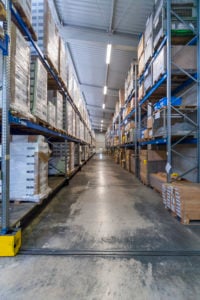
Limiting Supply Chain Disruption on Your Ecommerce Business
Optimizing and preserving the supply chain is critical for maintaining quality standards, minimizing costs, and satisfying customers. Companies that master the art of supply chain management tend to gain the trust and confidence of their customers and maintain quality control over their products. However, it’s reasonable to expect that your supply chain will fall short of perfection from time to time. So, it’s critical to understand how to mitigate the impact of supply chain disruption on your business. Proper techniques and backup plans will minimize the damage of future disruptions and supply chain challenges to your company and help to avoid negative customer experiences and feedback.
WHAT IS SUPPLY CHAIN DISRUPTION?
The supply chain encompasses the end-to-end process of making and delivering a product to the intended consumer. While it may seem straightforward, it’s a complex workflow that often involves an entire network of people and organizations and a long list of carefully planned activities. Key players in the supply chain include suppliers, manufacturers, vendors, warehouses, the business itself, distribution companies, shipping and delivery services, and retailers. Some of the functional roles within a supply chain include product development, sourcing, planning, replenishment, marketing, sales, operations, finance, and customer service.
organizations and a long list of carefully planned activities. Key players in the supply chain include suppliers, manufacturers, vendors, warehouses, the business itself, distribution companies, shipping and delivery services, and retailers. Some of the functional roles within a supply chain include product development, sourcing, planning, replenishment, marketing, sales, operations, finance, and customer service.
A supply chain disruption is any interruption in the process. It can occur at any point or multiple points throughout the supply chain. One recent example is the pandemic, which led to shortages that have significantly altered supply chain challenges across the globe. Fortune reported that 94% of Fortune 1000 companies experienced supply chain disruptions as a result of COVID-19. Some reasons for supply issues may include lockdowns, lack of workers, limited access to source materials, heightened restrictions, political clashes, natural disasters, technological problems, miscommunication, port congestion, and shipping delays.
HOW TO MITIGATE THE IMPACT OF SUPPLY CHAIN CHALLENGES ON YOUR ECOMMERCE BUSINESS.
One of the best ways to mitigate the impact of supply chain disruption and maintain a healthy end-to-end process is to anticipate issues and have backup plans to address them. Here are some strategies and tools that can help with managing supply chain challenges.
INVEST IN DATA AND INTEGRATED TECHNOLOGIES
Supply chain challenges are more likely to occur as the chain increases in complexity. To resolve these issues that exceed human or manual capabilities, savvy companies leverage data and technology solutions. This helps improve transparency, provide greater visibility into each component of the chain, and detect and address issues immediately. Inventory management software is an excellent example of technology that can help companies avoid or respond quickly to problems as they arise.
When a tech suite is integrated and structured appropriately, relevant parties internally or at partner companies should be able to view the full supply chain and receive alerts if an error occurs, a delay is detected, or a step is skipped. Immediate detection, accurate diagnostics, and rapid problem-solving are crucial to preventing significant issues, and the right tech tools will enable companies to achieve these goals.
Some technologies like artificial intelligence (AI) and machine learning could eventually predict problems before they happen by recognizing patterns and learning from previous experiences. This would place your company at an advantage, enabling you to stock up on inventory or make other necessary adjustments before your competition is even alerted to the issue.
DIVERSIFY
When issues like political conflicts or pandemic-related lockdowns arise in various parts of the globe, it becomes apparent why diversification is crucial to sustained business success. One prime example of this issue is American companies’ dependence on China, which has been in the economic spotlight for over a decade.  As business leaders and economists question out loud if our reliance on China’s exports places American companies and people in a vulnerable situation, the pandemic forced an answer. Lack of access to essential manufacturing components and products like medical supplies highlighted that the lack of diversification within companies’ manufacturing partners put them, their customers, and the nation at risk.
As business leaders and economists question out loud if our reliance on China’s exports places American companies and people in a vulnerable situation, the pandemic forced an answer. Lack of access to essential manufacturing components and products like medical supplies highlighted that the lack of diversification within companies’ manufacturing partners put them, their customers, and the nation at risk.
A similar issue arose in the case of the shortage of car chips made in Taiwan. The global automotive industry has become increasingly dependent on Taiwan for the many microchips required for modern cars to run. So, a shortage of chips has caused automakers to halt production, with up to one-year delays on new car orders. A recent drought in Taiwan compounded the issue of water-dependent technology, bringing to the surface another factor that is more at play as time goes on—environmental factors.
CONDUCT A SELF-ASSESSMENT
Harvard Business Review points out, that identifying your company’s vulnerabilities is crucial to overcoming or preventing supply chain disruption. This is an example of proactive ecommerce supply chain management. When working through this process, analyze each component of the supply chain and evaluate its risk for issues. The answers will help your team prioritize goals and devise backup strategies. Part of this assessment should include calculating how long your company can survive without each component of the chain—based on inventory and cash flow.
How much lead time do you have with your current finances and inventory before you need to make your next sale? The longer you can exist off of your current cash flow while continuing to fulfill orders, the better. However, there are real limitations to how much product you can accumulate before running out of space or depleting your financial resources. If the answer to the question above scares you, it may be time to reassess your current supply chain and inventory management strategy.
FOCUS ON EFFICIENCY
Every ounce of time, resources, and cost that your company can save will benefit you in the long run. These savings add up to provide you with a longer runway when problems arise. Additionally, the fewer unnecessary steps in your supply chain, the fewer components can go wrong. Streamlining the process helps to reduce your risk, refocus your team and system on the essential aspects of the chain, and ensure the entire supply chain is functioning correctly.
SUPPORT OPEN COMMUNICATION
Communication between team members and partner companies is critical to creating a healthy supply chain. The technology you choose can help facilitate this process, especially across geographically diverse offices. Regular communication between the various links in your supply chain can help raise awareness of potential vulnerabilities and address issues while they are still manageable. Additionally, as issues arise, the excellent relationships you facilitate between colleagues and partners will help foster an environment of collaboration and creative problem-solving that is necessary to solve crises, especially on a global level.
TAKE CARE OF YOUR PEOPLE
A critical component of the supply chain is the health and happiness of the people who work within it. Investing in workplace safety and employees’ health can help limit interruptions due to workforce shortages or high turnover rates. Companies that have a good relationship with their employees get better quality work, greater productivity, and fewer gaps in production than other companies. Studies show that the healthier and safer a workforce is, the more money a company can save in the long run. As companies struggle to compete for new hires right now, it’s a good reminder that internal culture and values reflected in health and safety policies can help attract talent in a competitive market.
CONCLUSION
While supply chain disruption may sometimes be inevitable and out of your control, you have the power to minimize the impact of major supply chain challenges by developing contingency plans and putting the right technologies and tools in place to detect and mitigate problems early. Strategies like diversification, proper communication, process efficiencies, and investment in data-driven technology enable ecommerce companies to gain a clearer vision of their processes, predict potential issues before they happen, and remain responsive and flexible in critical situations.
